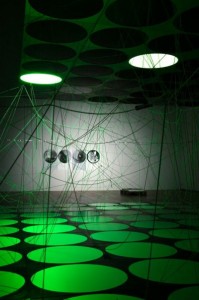Art Movements of 2000s: Relational Art
Relational Art
Relational Art or “Relational Aesthetics” is a mode or tendency in fine art practice originally observed and highlighted by French art critic Nicolas Bourriaud. Bourriaud defined the approach simply as, “a set of artistic practices which take as their theoretical and practical point of departure the whole of human relations and their social context, rather than an independent and private space.”

Angela Bulloch
Origin of the term
One of the first attempts to analyze and categorize art from the 1990s, the idea of Relational Art was developed by Nicolas Bourriaud in 1998 in his book Esthétique relationnelle(Relational Aesthetics). The term was first used in 1996, in the catalogue for the exhibition Traffic curated by Bourriaud at CAPC musée d’Art contemporain de Bordeaux. Trafficincluded the artists that Bourriaud would continue to refer to throughout the 1990s, such as Henry Bond, Liam Gillick, Rirkrit Tiravanija, Philippe Parreno, Pierre Huyghe, Carsten Höller, Christine Hill, Vanessa Beecroft, Maurizio Cattelan and Jorge Pardo.
Relational Aesthetics
Bourriaud wishes to approach art in a way that ceases “to take shelter behind Sixties art history” , and instead seeks to offer different criteria by which to analyse the often opaque and open-ended works of art of the 1990s. To achieve this, Bourriaud imports the language of the 1990s internet boom, using terminology such as user-friendliness, interactivity and DIY (do-it-yourself). In his 2002 book Postproduction: Culture as Screenplay: How Art Reprograms the World, Bourriaud describes Relational Aesthetics as a book addressing works that take as their point of departure the changing mental space opened by the internet.
Relational Art
Artists included by Bourriaud under the rubric of Relational Aesthetics include: Rirkrit Tiravanija, Philippe Parreno, Carsten Höller, Henry Bond, Douglas Gordon and Pierre Huyghe.
Bourriaud explores this notion of relational aesthetics through examples of what he calls Relational Art. According to Bourriaud, Relational Art encompasses “a set of artistic practices which take as their theoretical and practical point of departure the whole of human relations and their social context, rather than an independent and private space.”
The artwork creates a social environment in which people come together to participate in a shared activity. Bourriaud claims “the role of artworks is no longer to form imaginary and utopian realities, but to actually be ways of living and models of action within the existing real, whatever scale chosen by the artist.”
In Relational Art, the audience is envisaged as a community. Rather than the artwork being an encounter between a viewer and an object, relational art produces intersubjective encounters. Through these encounters, meaning is elaborated collectively, rather than in the space of individual consumption.
Critical reception
Writer and director Ben Lewis has suggested that relational art is the new “ism”, in analogue with “ism”s of earlier periods such as impressionism, expressionism and cubism. Lewis finds many similarities between relational art and earlier “ism”s at their beginnings: relational art is often not considered art at all because it redefines the concept of art, many artists considered “relational” deny that they are such and relational art had a “founding” exhibition.
In “Antagonism and Relational Aesthetics”, published in 2004 in October, Claire Bishop describes the aesthetic of Palais de Tokyo as a “laboratory”, the “curatorial modus operandi” of art produced in the 1990s. Bishop identifies Bourriaud’s book as an important first step in identifying tendencies in contemporary art. However, Bishop, also asks “if relational art produces human relations, then the next logical question to ask is what types of relations are being produced, for whom, and why?” She continues that “the relations set up by relational aesthetics are not intrinsically democratic, as Bourriaud suggests, since they rest too comfortably within an ideal of subjectivity as whole and of community as immanent togetherness.”
The University of New Mexico’s College of Fine Arts links its fine arts program with the ideas of relational art.
Exhibitions
In 2002, Bourriaud curated an exhibition at the San Francisco Art Institute, Touch: Relational Art from the 1990s to Now, “an exploration of the interactive works of a new generation of artists.” Exhibited artists included Angela Bulloch, Liam Gillick, Felix Gonzalez-Torres, Jens Haaning, Philippe Parreno, Gillian Wearing and Andrea Zittel. Critic Chris Cobb suggests that Bourriaud’s “snapshot” of 1990s art is a confirmation of the term (and idea) of Relational Art, while illustrating “different forms of social interaction as art that deal fundamentally with issues regarding public and private space.”
Source: en.wikipedia.org.com


This Post Has 0 Comments